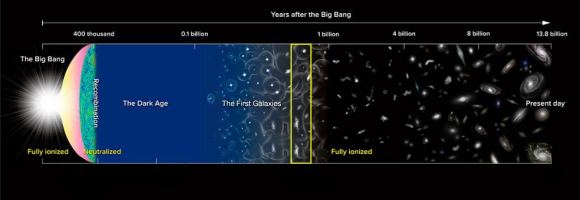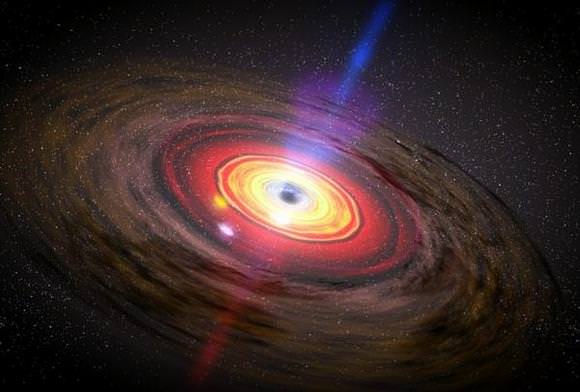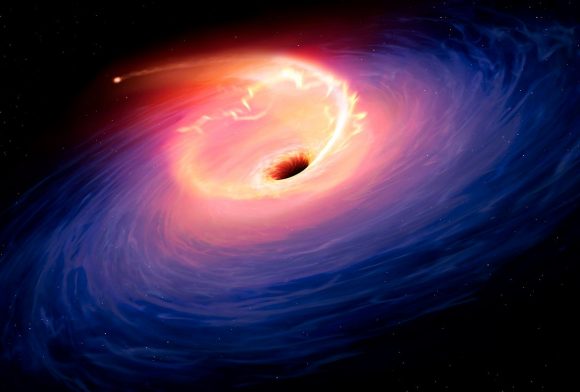In accordance with the Big Bang model of cosmology, shortly after the Universe came into being there was a period known as the "Dark Ages". This occurred between 380,000 and 150 million years after the Big Bang, where most of the photons in the Universe were interacting with electrons and protons. As a result, the radiation of this period is undetectable by our current instruments – hence the name.
Astrophysicists and cosmologists have therefore been pondering how the Universe could go from being in this dark, cloudy state to one where it was filled with light. According to a new study by a team of researchers from the University of Iowa and the Harvard-Smithsonian Center for Astrophysics, it may be that black holes violently ejected matter from the early Universe, thus allowing light to escape.
Their study, titled "Resolving the X-ray emission from the Lyman continuum emitting galaxy Tol 1247-232", recently appeared in the Monthly Notices of the Royal Astronomical Society. Led by Phillip Kaaret, a professor of Physics and Astronomy at the University of Iowa - and supported by an award from the Chandra X-ray Observatory - the research team arrived at this conclusion by observing a nearby galaxy from which ultraviolet light is escaping.

Milestones in the history of the Universe, from the Big Bang to the present day. Credit: NAOJ/NOAO
This galaxy, known as Tol 1247-232, is a small (and possibly elliptical) galaxy located 652 million light-years away, in the direction of the southern Hydra constellation. This galaxy is one of just nine in the local Universe (and one of only three galaxies close to the Milky Way) that has been shown to emit Lyman continuum photons - a type of radiation in the ultraviolet band.
Back in May of 2016, the team spotted a single X-ray source coming from a star-forming region in this galaxy, using the Chandra X-ray observatory. Based on their observations, they determined that it was not caused by the formation of a new star. For one, new stars do not experience sudden changes in brightness, as this x-ray source did. In addition, the radiation emitted by new stars does not come in the form of a point-like source.
Instead, they determined that what they were seeing had to be the result of a very small object, which left only one likely explanation: a black hole. As Philip Kaaret, a professor in the UI Department of Physics and Astronomy and the lead author on the study, explained:
"The observations show the presence of very bright X-ray sources that are likely accreting black holes. It's possible the black hole is creating winds that help the ionizing radiation from the stars escape. Thus, black holes may have helped make the universe transparent."

Artist concept of matter swirling around a black hole. Credit: NASA/Dana Berry/SkyWorks Digital
However, this also raised the question of how a black hole could be emitting matter. This is something that astrophysicists have puzzled over for quite some time. Whereas all black holes have tendency to consume all that is in their path, a small number of supermassive black holes (SMBHs) have been found to have high-speed jets of charged particles streaming from their cores.
These SMBHs are what power Active Galactic Nuclei, which are compact, bright regions that has been observed at the centers of particularly massive galaxies. At present, no one is certain how these SMBHs manage to fire off jets of hot matter. But it has been theorized that they could be caused by the accelerated rotational energy of the black holes themselves.
In keeping with this, the team considered the possibility that accreting X-ray sources could explain the escape of matter from a black hole. In other words, as a black hole's intense gravity pulls matter inward, the black hole responds by spinning faster. As the hole's gravitational pull increases, the speed creates energy, which inevitably causes charged particles to be pushed out. As Kaaret explained:
"As matter falls into a black hole, it starts to spin and the rapid rotation pushes some fraction of the matter out. They're producing these strong winds that could be opening an escape route for ultraviolet light. That could be what happened with the early galaxies."

Depiction of the tidal disruption event in F01004-2237. The release of gravitational energy as the debris of the star is accreted by the black hole leads to a flare in the optical light of the galaxy. Credit and copyright: Mark Garlick
Taking this a step further, the team hypothesized that this could be what was responsible for light escaping the "Dark Ages". Much like the jets of hot material being emitted by SMBHs today, similarly massive black holes in the early Universe could have sped up due to the accretion of matter, spewing out light from the cloudiness and allowing for the Universe to become a clear, bright place.
In the future, the UI team plans to study Tol 1247-232 in more detail and locate other nearby galaxies that are also emitting ultraviolet light. This will corroborate their theory that black holes could be responsible for the observed point source of high-energy X-rays. Combined with studies of the earliest periods of the Universe, it could also validate the theory that the "Dark Ages" ended thanks to the presence of black holes.
Further Reading: Iowa Now, Monthly Notices of the Royal Astronomical Society
No comments:
Post a Comment